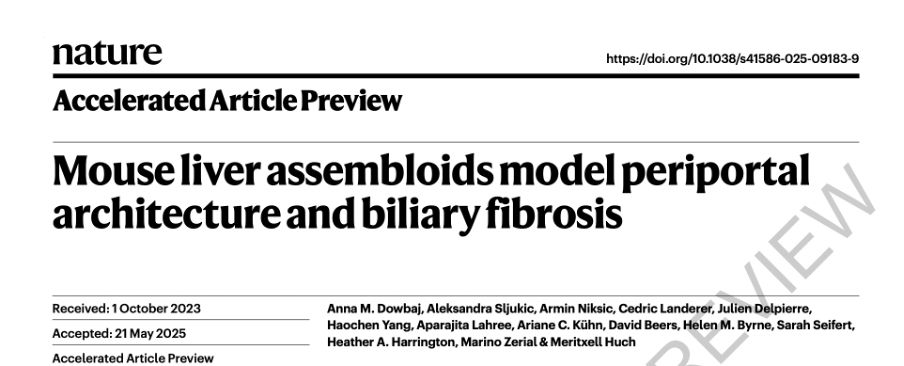Mouse liver assembloids model periportal architecture and biliary fibrosis - Nature
Nature - Mouse liver assembloids model periportal architecture and biliary fibrosis
And knocking out ITGB1 prevented compaction of assembloids and reduced collagen fibre accumulation, meaning integrins are essential for mesenchymal activation and fibrosis. See the paper here for more: www.nature.com/articles/s41...
04.06.2025 12:58 — 👍 0 🔁 0 💬 0 📌 0
Being able to detect this shape change meant we could perform knockouts and see the shape effects. Knocking out CDH11 prevented the typical fibrotic shape change of assembloids, which means that CDH11-mediated adhesion between mesenchymal cells is critical for triggering fibrosis.
04.06.2025 12:58 — 👍 0 🔁 0 💬 1 📌 0

The DETECT Distance Ratio combines this information for an assembloid between timepoints with information about the shape of a healthy assembloid. The higher the DETECT Distance Ratio, the greater the morphological change over time, and the more likely scarring is present.
04.06.2025 12:58 — 👍 0 🔁 0 💬 1 📌 0

Media
(See our video here for more on the ECT: www.mpi-cbg.de/research/res...)
04.06.2025 12:58 — 👍 0 🔁 0 💬 1 📌 0
This is where maths comes in. In this paper, we introduce a shape comparator metric - the DETECT Distance Ratio - which enables the change in shape of these assembloids to be studied over time.
04.06.2025 12:58 — 👍 0 🔁 0 💬 1 📌 0

New interdisciplinary math+bio paper! Mouse liver assembloids model periportal architecture and biliary fibrosis. In vitro assembloids modelling the mouse liver periportal region were built to study processes causing scarring (cholestatic injury/biliary fibrosis) and the shape change this causes.
04.06.2025 12:58 — 👍 6 🔁 2 💬 1 📌 1
Mouse liver assembloids model periportal architecture and biliary fibrosis - Nature
Nature - Mouse liver assembloids model periportal architecture and biliary fibrosis
And knocking out ITGB1 prevented compaction of assembloids and reduced collagen fibre accumulation, meaning integrins are essential for mesenchymal activation and fibrosis. See the paper here for more: www.nature.com/articles/s41...
04.06.2025 12:50 — 👍 0 🔁 0 💬 0 📌 0
Being able to detect this shape change meant we could perform knockouts and see the shape effects. Knocking out CDH11 prevented the typical fibrotic shape change of assembloids, which means that CDH11-mediated adhesion between mesenchymal cells is critical for triggering fibrosis.
04.06.2025 12:50 — 👍 0 🔁 0 💬 1 📌 0

The DETECT Distance Ratio combines this information for an assembloid between timepoints with information about the shape of a healthy assembloid. The higher the DETECT Distance Ratio, the greater the morphological change over time, and the more likely scarring is present.
04.06.2025 12:50 — 👍 0 🔁 0 💬 1 📌 0
Media
(See our video here for more on the ECT: www.mpi-cbg.de/research/res...)
04.06.2025 12:50 — 👍 0 🔁 0 💬 1 📌 0
We start with the shape metric developed in the DETECT paper (published here) that uses the Euler Characteristic Transform (ECT) to track topological features of the object (edges, vertices, faces) in multiple directions (the final metric is orientation agnostic).
04.06.2025 12:50 — 👍 0 🔁 0 💬 1 📌 0
This is where maths comes in. In this paper, we introduce a shape comparator metric - the DETECT Distance Ratio - which enables the change in shape of these assembloids to be studied over time.
04.06.2025 12:50 — 👍 0 🔁 0 💬 1 📌 0
proud papa | group leader team stembryo @ MPI-CBG Dresden | re- and deconstructing (st)embryos | #stembryogenesis | solves problems in lab & climbing hall | views mine
Mathematician and neuroscientist working on Alzheimer’s disease
Currently at Lund University, previously at Ox Maths
Lecturer in Mathematical Sciences at the University of South Australia.
www.ryanmurphyresearch.com
Postdoc at @mpi-cbg.de and @csbdresden.bsky.social
Interested in algebra, geometry and applications to lIfe Sciences
Hiker, runner, swimmer and mathematician. Interested in applied and computational aspects of algebraic geometry. He/him.
postdoc at max planck institute for cell biology and genetics. mathematician, formerly phd @ epfl
PhD student at @oxfordmathematics.bsky.social, interested in spatial biology and TDA.
https://www.sergio-sdhi.com
🍩 Postdoc at Queen Mary, working on Geometric Data Analysis
🎓 Formerly at Oxford and Postech
🏳️⚧️ Trans non-binary, Any pronouns :)
✨ Also: number theory, physics, art, music
https://sites.google.com/view/uzulim/main
Mathematician interested in data & biology. Max Planck Institute & TU Dresden. Oxford Maths Institute & St John’s College, Oxford. Previously Imperial College London & Umass Amherst.
Ahhh yes, I love numbers and stuff!
PhD Student in Heather Harrington's group at MPI-CBG
Mathematician
ELBE postdoctoral fellow between MPI CBG and MPI PKS
science, strategy, and scicomms @math-mpicbg.bsky.social
some kind of biologist, surrounded by mathematicians
eyebrows raise with joy at the sight of any animal
Mathematicians developing mathematics and methods to look at living systems differently.
Colocated at @mpi-cbg.de and @csbdresden.bsky.social in Dresden, Germany.



